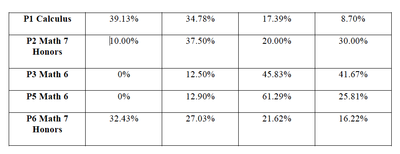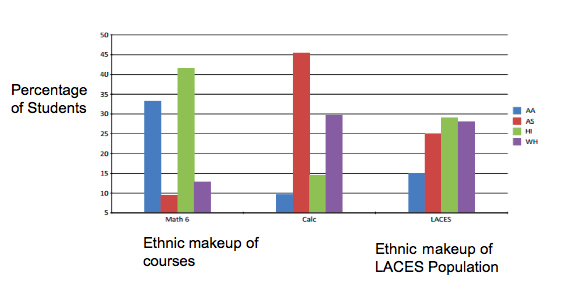Leadership Project: De-tracking
Topic and Rationale
My topic was founded last year as one of my colleagues and I were analyzing our students’ CST data. We discovered that 80% of our 6th grade math students scored Proficient or Advanced on the math portion of their 5th grade CSTs. We then examined the 6th grade math CST scores from the same year, and found that the amount of students who had scored Proficient or Advanced had drastically dropped. The 7th grade math CST scores were even lower than those of the 6th grade scores, and Algebra 1 CST data was unequivocally lower than the 7th grade math CST scores.
This data seems dubious because I work in one of the highest performing schools in LAUSD and we are acknowledged for our high academic achievements. Despite this recognition, the number of students performing Proficient or Advanced by the time they’re in 8th grade drop to about 40%, which is half the amount of students who scored proficient or advanced in the 5th grade. This led me to explore these issues that affect our student population's severe drops in scores from 5th grade to Algebra 1.
Tracking
The question then became, which students are scoring so low? Is there a correlation between specific groups of students and low CST scores? This topic intrigued me because Latino and African American students are explicitly marginalized at our school. More specifically, our math classes are tracked from the moment that students are enrolled. The makeup of students in the honors math classes consist of White and Asian students while the regular math classes mostly consist of students of Latino and African American ethnic backgrounds. Most math teachers do not question the reasons as to why our classes are so homogeneous. When questioned, it is justified with deficit perspectives about lazy kids in regular classes and other similar statements. I wondered whether looking at CST data would help surface the unequal opportunities that are given to specific students. If it does, presenting such findings to faculty will help in changing perspectives as to why we accept things as is, and what can be done to change the current state. My hypothesis is that there is a parallel between particular groups at our school and student groups that have been historically marginalized. I want to address creating more equal educational opportunities for students of all backgrounds that attend our school. If this parallel does not exist, other ideas and conclusions should be discussed as it will present different findings that will inform our school culture as well as academic achievement.
My Team
My team was comprised of the school principal and a fellow math teacher. As the principal is responsible for the CST data, he continuously provided supplementary data for me us to review. While prior data is important, it will also be interesting to disaggregate Common Core State Standard data once the tests have been implemented and the scores have been released.My second team member, another math teacher at LACES, helped me conduct the research and discover the disparaging scores. She also analyzed the data so we could have a second perspective, enabling us to bounce ideas from one another. The team met 3 times a week during our common planning period to discuss our findings.
My Role
1. Put together a team that would analyze student data to find the root causes of race-based segregation in our math classes
2. Disagregate data based on grade, ethnicity, and previous courses taken
3. Create an action plan that addresses root causes
4. Share findings with colleagues
Literature Analysis
School Data Summary and Analysis
Ms. Song's 2012-2013 Math 7 Honors Class Picture

Ms. Song's 2012-2013 Math 7 Class Picture

2012-2013 was my first year at LACES, and I immediately noticed the differences between my Math 6 and Math 7 honors courses. Students are required to take a math placement diagnostic during the summer before 6th grade, which means that students are segregated into different tracks based on their diagnostic score even before their first day of school. Such tracking segregates students of the same grade and age by ethnic background.
The students in both of the pictures above are of the same age except for a handful of 7th graders in Math 7 honors. Even though the ethnic stratification is obvious, I never had the right perspective or knowledge to define what was wrong or pinpoint why the makeup of each class was unfair. The research relayed in the tracking articles by Ballon, Burris, and Riegle-Crumb describe the injustices that come with tracking students in the way that LACES does so.
When looking at the pictures of my classes, one might say that the honors course is predominantly White and Asian while the non-honors course is predominantly Black and Latino just by chance. However, the following table and bar graph shows stratification, yet again, within the math courses that I am teaching this year (table) and within the enrollment of all of the AP Calculus and Math 6 courses at LACES this year (bar graph).
While my 7th grade honors course is a fairly mixed course, my Math 6 courses and AP Calculus course are not. Over 80% of the students are Black and Latino in my Math 6 courses, and there are no Asian students in this class. Contrastingly, about 75% of my Calculus course consists of Asian and White students.
It is important to note the ethnic makeup of the student population at LACES. The last tripod of bars in the bar graph above shows the ethnic makeup of our school in percentages. Our students are 15% African American, 25% Asian, 28% Hispanic, and 27% White. Our classes should represent the same ratios of students as our school population does so that students in each ethnic group receive equal amounts of opportunities. While Asians and Whites make up 52% of our population, they makeup an overwhelming majority of the Calculus courses (75%). It is also important to note that the 6th grade courses are predominantly Black and Latino despite our diverse student population because a large amount of 6th graders are pushed into 7th grade honors courses.
The bar graph also shows evidence about the ways in which our tracking system clusters our students based on ethnicity. Although this may be an unintended outcome, Data 3 showcases the ethnic makeup of courses between our lowest and highest math course. Data 3 shows the percentages of students by ethnicities that are enrolled in Math 6 and Calculus for the current school year of 2013-2014. Math 6 and Calculus enrollment data are essentially the opposites of each other in that the bulk of the students in Math 6 are African American and Latino while the bulk of the students in Calculus are White and Asian.
Future Implications
The best way to prove that de-tracking results in better achievement for all is to provide data that proves the aforementioned theories. In response to this, our principal has agreed to experimentally un-track our 6th grade math courses for the upcoming school year. While this is a step in the right direction, we have a lot of work ahead of us. The following are ideas that may be implemented for our de-tracked, 6th grade math courses:
1. Provide an extra math course that acts as a supplementary course to the core math course
2. Implement curriculum that caters to students of all backgrounds. Support teachers in using this type of curriculum
3. Enlist the help of older, high school students who are willing to tutor/support our 6th graders in these math courses. Create structures that support this type of tutoring (ie. club)
4. Enlist the help of stakeholders other than teachers such as students and parents who can speak about their own or their child's experiences in the de-tracked classroom.
Reflection
The hardest thing about attempting to de-track our classes has been addressing deficit views about marginalized students. We have never addressed why there exist so many African American and Latino students in the lower tracks, and it has been difficult to be the voice and face of such a controversial theory. If the process of de-tracking does not result in higher achievement data, supporters of the LACES tracking system will have more reason to disagree with having de-tracked, heterogeneous classes. While I attempt to address these equity issues, my action plan is to get more teachers involved in this project in hopes that support will come in numbers. It has become evident throughout the year that this type of change requires the support and buy-in from a team that is bigger than the 3 person team (two math teachers and principal) we’ve been working in this year. Additionally, de-tracking will not be the end all and be all to providing equitable access for all of our students. Within the next year, I am hoping to create support systems and departmental, cultural changes that will help our heterogeneous courses be successful.
CPSEL Connection
Standard 1- Facilitating the development, articulation, implementation, and stewardship of a vision of learning that is shared and supported by the school community.
1.1- Facilitate the development of a shared vision for the achievement of all students based upon data from multiple measures of student learning and relevant qualitative indicators.
1.3 -Use the influence of diversity to improve teaching and learning.
1.4 -Identify and address any barriers to accomplishing the vision.
1.5 -Shape school programs, plans, and activities to ensure that they are integrated, articulated through the grades, and consistent with the vision.
Standard 2 - Advocating, nurturing, and sustaining a school culture and instructional program conducive to student learning and staff professional growth.
2.2 - Promote equity, fairness, and respect among all members of the school community
Standard 3 - Ensuring management of the organization, operations, and resources for a safe, efficient, and effective learning environment.
3.3 - Establish school structures and processes that support student learning
Standard 5 - Modeling a personal code of ethics and developing professional leadership capacity.
5.4 - Make and communicate decisions based upon relevant data and research about effective teaching and learning, leadership, management practices, and equity.
5.6 - Demonstrate skills in decision-making, problem solving, change management, planning, conflict management, and evaluation.
Standard 6 - Understanding, responding to, and influencing the larger political, social, economic, legal, and cultural context.
6.6 - View oneself as a leader of a team and also as a member of a larger team.
Supporting Document
1. Logic Model
2. Burris Article on De-tracking



